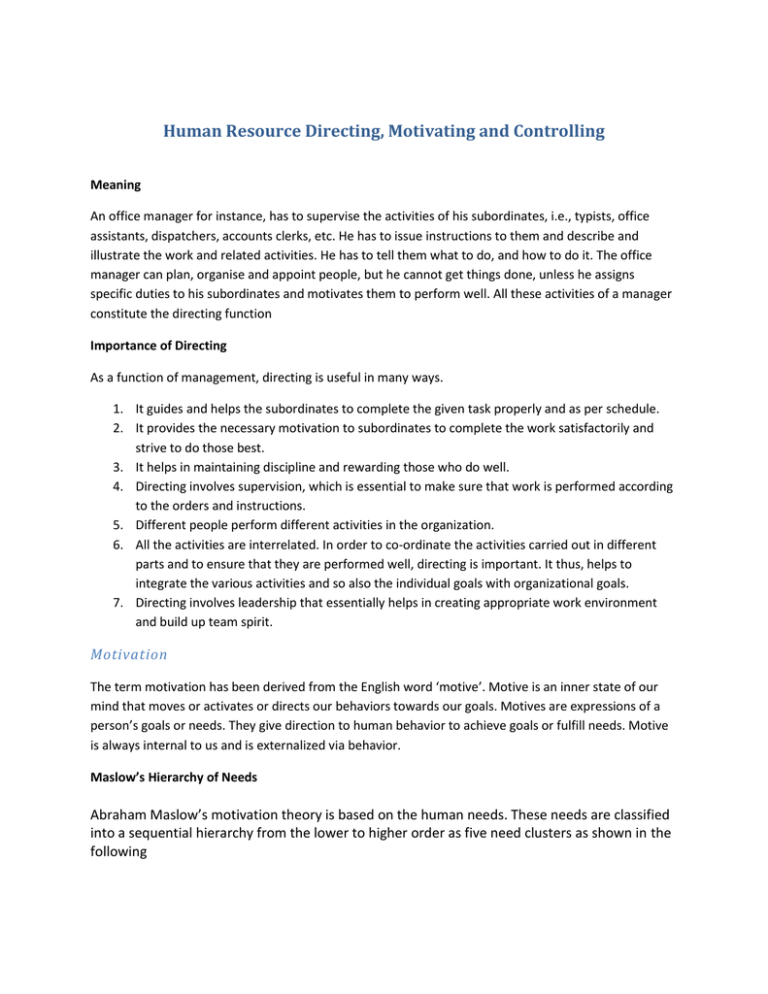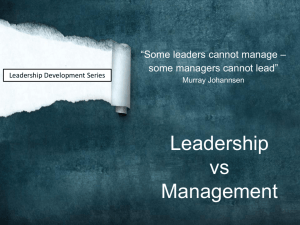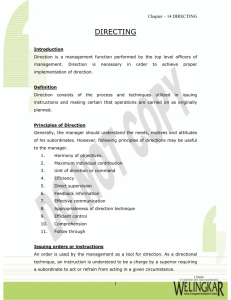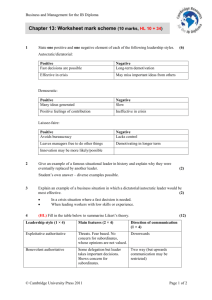Human Resource Directing, Motivating and Controlling
advertisement

Human Resource Directing, Motivating and Controlling Meaning An office manager for instance, has to supervise the activities of his subordinates, i.e., typists, office assistants, dispatchers, accounts clerks, etc. He has to issue instructions to them and describe and illustrate the work and related activities. He has to tell them what to do, and how to do it. The office manager can plan, organise and appoint people, but he cannot get things done, unless he assigns specific duties to his subordinates and motivates them to perform well. All these activities of a manager constitute the directing function Importance of Directing As a function of management, directing is useful in many ways. 1. It guides and helps the subordinates to complete the given task properly and as per schedule. 2. It provides the necessary motivation to subordinates to complete the work satisfactorily and strive to do those best. 3. It helps in maintaining discipline and rewarding those who do well. 4. Directing involves supervision, which is essential to make sure that work is performed according to the orders and instructions. 5. Different people perform different activities in the organization. 6. All the activities are interrelated. In order to co-ordinate the activities carried out in different parts and to ensure that they are performed well, directing is important. It thus, helps to integrate the various activities and so also the individual goals with organizational goals. 7. Directing involves leadership that essentially helps in creating appropriate work environment and build up team spirit. Motivation The term motivation has been derived from the English word ‘motive’. Motive is an inner state of our mind that moves or activates or directs our behaviors towards our goals. Motives are expressions of a person’s goals or needs. They give direction to human behavior to achieve goals or fulfill needs. Motive is always internal to us and is externalized via behavior. Maslow’s Hierarchy of Needs Abraham Maslow’s motivation theory is based on the human needs. These needs are classified into a sequential hierarchy from the lower to higher order as five need clusters as shown in the following The above five need-clusters are now discussed in seriatim: 1. Physiological Needs: These needs are of the lowest-order and most basic needs of human beings. These involve satisfying fundamental biological drives, such as the need for food, air, water, cloth, and shelter generally expressed in the names of roti, kapada aur makan. These needs exert tremendous influence on human behaviour. Entrepreneur also being a human being has to meet his physiological needs for survival. Hence, he / she is motivated to work in the enterprise to have economic rewards to meet his / her basic needs. 2. Safety and Security Needs: The second level of need in Maslow’s hierarchy is emerged once physiological needs are met. Safety needs involve the need for a secure environment, free from threats of physical and psychological harm. These needs find expression in such desires as economic security and protection from physical dangers. Meeting these needs requires more money and, hence, the entrepreneur is prompted to work more in his/ her entrepreneurial pursuit. Like physical needs, these become inactive once they are also satisfied. 3. Social Needs: Man is social animal. These needs, therefore, refer to belongingness or affiliation. All individuals want to be recognized and accepted by others. Likewise, an entrepreneur is motivated to interact with fellow entrepreneurs, his employees, and others. 4. Esteem Needs: These needs refer to self-esteem and self-respect. These include such needs that indicate self-confidence, achievement, competence, knowledge, and independence. In case of entrepreneurs, the ownership and self- control over enterprise satisfies their esteem needs by providing them status, respect, reputation, and independence. 5. Self-Actualization: The final step under the need hierarchy model is the need for selfactualization. This refers to self- fulfillment. The term ‘self- actualization’ was coined by Kurt Goldstein and means to become actualized in what one is potentially good. An entrepreneur may achieve self-actualization in being a successful entrepreneur. In Maslow’s above need hierarchy theory, human needs are arranged in a lowest to the highest order. The second need does not dominate unless the first is reasonably satisfied and the third need does not dominate until the first two needs have been reasonably satisfied. This process goes on till the last need. This is because man is never satisfied. If one need is satisfied, another need arises. Once a need is satisfied, it ceases to be a motivating factor. For entrepreneurs, it is mainly social, esteem, and self-actualization needs which motivate them to work more and more for satisfying them. Leadership Leadership may be defined as a position of power held by an individual in a group, which provides him with an opportunity to exercise interpersonal influence on the group members for mobilizing and directing their efforts towards certain goals. The leader is at the centre of group’s power structure, keeps the group together, infuses life into it, moves it towards its goals and maintains its momentum. Leadership Styles 1. Autocratic Style: Under the autocratic leadership style, all decision-making powers are centralized to the leader. The autocratic management has been successful as it provides strong motivation to the manager. It permits quick decision making, as only one person decides for the whole group. 2. Bureaucratic Style: This style of leadership is mostly followed in government departments. Employees strictly follow all rules and regulations. 3. Consultative Style: Under this style the leader consults the subordinates before taking a decision 4. Participative Style: The democratic leadership style favors decision making by the group, and such leaders give instruc-tion after consulting the group. They can win the cooperation of their group and can motivate them effectively and positively. 5. Laissez-faire Style: This type of leader does not lead, but leaves the group entirely to itself; such a leader allows maxi-mum freedom to subordinates. Subordinates are given a free hand in deciding their own policies and methods. 6. Paternalistic Style: The paternalistic style aims at creating a family atmosphere and is followed in Japanese organizations. 7. Sociocratic Style: This style of leader runs the organization like a social club. For such a leader, the interest of the subor-dinates come first and then that of the organization. 8. Situational Style: Different situations call for different leadership styles. In an emergency when there is little time to come together on an agreement and where a leader has considerably more experience or expertise, an autocratic leadership style may be most effective; however, in a highly motivated and united team with a similar level of expertise, a more democratic or laissezfaire style may be more effective. Controlling Meaning Controlling is the basic managerial function. It is the process of ensuring the actual activities confined to planned activity. It is an essential function for all levels of management. It ensures the right things are done in the right manner at right time. Each and every organization set the goals. All activities are directed towards the goals. Controlling is defined as a measurement of Actual performance and expected performance and taking corrective action. Its purpose is to make sure that actual performance is consistent with plans. In fact control helps managers to monitor the effectiveness of their planning, their organizing and their directing activities. Essentials of a Sound Control System 1. Focus on Objectives: The control system should always focus on objectives. It should aim to achieve the objectives of the organisation. 2. Suitability: The control system should be suitable to the needs of the organisation. 3. Promptness: The control system should be prompt. That is, it should find out the deviations quickly. This will help the management to correct the deviations quickly. 4. Flexibility: The control system should be flexible. It should change according to the changes in plans, situations, environments, etc. A rigid control system will always fail. Hence flexibility is necessary for a control system. 5. Forward Looking: The control system should be forward-looking. It should forecast the future deviations. That is, it should find out the deviations before it happens. It should also take steps to prevent these future deviations. 6. Economical: The control system should be economical. This means the cost of the control system should not be more than its benefits. 7. Simplicity: The control system should not be complicated. It should be easy to understand and simple to use. Those who are going to use the control system should understand it clearly and completely. 8. Motivating: The control system should be motivating. That is, it should give more importance to preventing the mistakes and less importance to punishing the employees. So, it should encourage, not discourage the employees. 9. Suggestive: The control system should be suggestive and it should give complete answers for the following questions :- What is the Problem? Where is the Problem? How to solve the Problem? 10. Proper Standards: The control system should have proper standards. The standards should be very clear. They should be definite, verifiable, specific and measurable. They should not be too high or too low.



